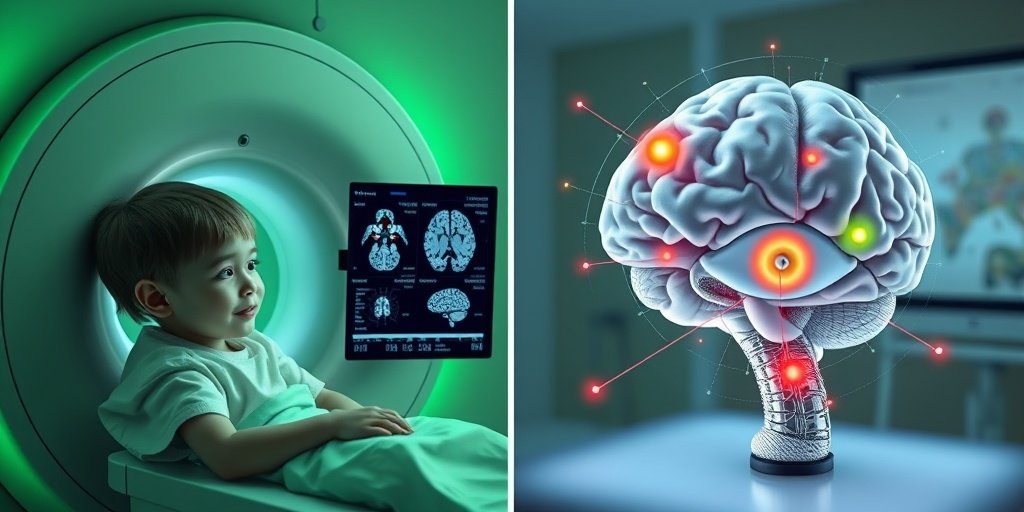⚡ Quick Summary
This study explored the use of machine learning and radiomics analysis to predict the risk of epilepsy in children with supratentorial low-grade glioma (LGG). The findings revealed that a model combining radiomics features and tumor location achieved an impressive accuracy of 93.8% in distinguishing epilepsy-associated cases.
🔍 Key Details
- 📊 Dataset: 48 children with LGG (23 with epilepsy, 25 without)
- 🧩 Features used: 206 radiomics features, voxel-based morphometry
- ⚙️ Technology: Linear Support Vector Machine (SVM)
- 🏆 Performance: Precision 95.5%, Recall 91.3%, Specificity 96.0%, AUC 0.950
🔑 Key Takeaways
- 🧠 Epilepsy significantly impacts children with brain tumors, necessitating precise diagnostic tools.
- 🔍 Radiomics analysis can effectively differentiate between epilepsy-associated and non-associated LGG.
- 📈 Temporal lobe involvement was identified as the most critical predictor of epilepsy risk.
- ⚙️ Machine learning models demonstrated high predictive performance, enhancing treatment planning.
- 🌟 Eight key radiomics features were identified as significant predictors of epilepsy.
- 📊 Voxel-based morphometry revealed notable differences in brain structure between groups.
- 💡 This study supports the integration of AI in pediatric neuro-oncology.
- 🌍 Conducted by a team of experts from various institutions, highlighting collaborative research efforts.

📚 Background
The relationship between epilepsy and pediatric brain tumors, particularly low-grade gliomas, is a critical area of research. Understanding how these tumors influence seizure activity can lead to better diagnostic and treatment strategies. With advancements in imaging techniques and machine learning, researchers are now able to analyze complex data sets to improve patient outcomes.
🗒️ Study
This study involved a cohort of 48 children diagnosed with supratentorial LGG, where researchers extracted radiomics features from T2-FLAIR MRI images. The aim was to differentiate between those with epilepsy and those without, using advanced statistical methods and machine learning algorithms to enhance predictive accuracy.
📈 Results
The analysis revealed significant differences in brain morphology, particularly in the temporal cortex and basal ganglia, between the two groups. The Linear Support Vector Machine model, which combined radiomics and tumor location features, achieved a remarkable accuracy of 93.8% and an AUC of 0.950, indicating its potential as a reliable tool for predicting epilepsy risk in children with LGG.
🌍 Impact and Implications
The implications of this research are profound. By utilizing machine learning and radiomics, clinicians can better predict which children with LGG are at risk for developing epilepsy. This predictive capability can lead to more tailored treatment plans, potentially improving the quality of life for young patients and their families. The integration of such technologies into clinical practice could revolutionize how we approach pediatric neuro-oncology.
🔮 Conclusion
This study highlights the transformative potential of machine learning in predicting epilepsy associated with supratentorial LGG in children. By leveraging advanced imaging and analytical techniques, healthcare professionals can enhance diagnostic precision and optimize treatment strategies. Continued research in this area is essential for further advancements in pediatric care.
💬 Your comments
What are your thoughts on the use of machine learning in predicting epilepsy in children with brain tumors? We would love to hear your insights! 💬 Join the conversation in the comments below or connect with us on social media:
Morphometric and radiomics analysis toward the prediction of epilepsy associated with supratentorial low-grade glioma in children.
Abstract
OBJECTIVES: Understanding the impact of epilepsy on pediatric brain tumors is crucial to diagnostic precision and optimal treatment selection. This study investigated MRI radiomics features, tumor location, voxel-based morphometry (VBM) for gray matter density, and tumor volumetry to differentiate between children with low grade glioma (LGG)-associated epilepsies and those without, and further identified key radiomics features for predicting of epilepsy risk in children with supratentorial LGG to construct an epilepsy prediction model.
METHODS: A total of 206 radiomics features of tumors and voxel-based morphometric analysis of tumor location features were extracted from T2-FLAIR images in a primary cohort of 48 children with LGG with epilepsy (N = 23) or without epilepsy (N = 25), prior to surgery. Feature selection was performed using the minimum redundancy maximum relevance algorithm, and leave-one-out cross-validation was applied to assess the predictive performance of radiomics and tumor location signatures in differentiating epilepsy-associated LGG from non-epilepsy cases.
RESULTS: Voxel-based morphometric analysis showed significant positive t-scores within bilateral temporal cortex and negative t-scores in basal ganglia between epilepsy and non-epilepsy groups. Eight radiomics features were identified as significant predictors of epilepsy in LGG, encompassing characteristics of 2 locations, 2 shapes, 1 image gray scale intensity, and 3 textures. The most important predictor was temporal lobe involvement, followed by high dependence high grey level emphasis, elongation, area density, information correlation 1, midbrain and intensity range. The Linear Support Vector Machine (SVM) model yielded the best prediction performance, when implemented with a combination of radiomics features and tumor location features, as evidenced by the following metrics: precision (0.955), recall (0.913), specificity (0.960), accuracy (0.938), F-1 score (0.933), and area under curve (AUC) (0.950).
CONCLUSION: Our findings demonstrated the efficacy of machine learning models based on radiomics features and voxel-based anatomical locations in predicting the risk of epilepsy in supratentorial LGG. This model provides a highly accurate tool for distinguishing epilepsy-associated LGG in children, supporting precise treatment planning.
TRIAL REGISTRATION: Not applicable.
Author: [‘Tsai ML’, ‘Hsieh KL’, ‘Liu YL’, ‘Yang YS’, ‘Chang H’, ‘Wong TT’, ‘Peng SJ’]
Journal: Cancer Imaging
Citation: Tsai ML, et al. Morphometric and radiomics analysis toward the prediction of epilepsy associated with supratentorial low-grade glioma in children. Morphometric and radiomics analysis toward the prediction of epilepsy associated with supratentorial low-grade glioma in children. 2025; 25:63. doi: 10.1186/s40644-025-00881-1